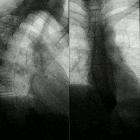Scleroderma (renal manifestations)
Renal manifestations of scleroderma are common, affecting up to 25% of patients. Some patients (5-10%) can present with a scleroderma renal crisis (SRC). These patients have an abrupt onset of hypertension and acute renal failure .
For a general discussion of scleroderma, please refer to the parent article: scleroderma.
Pathology
The pathophysiology is very similar to malignant nephrosclerosis and is characterized by pronounced constriction of arcuate and interlobular arterioles resulting in focal cortical ischemia. However, in scleroderma, this is a primary process that subsequently produces hypertension.
Histopathologic changes of small arcuate and interlobular arterioles are:
- fibrinoid necrosis
- hyperplastic fibroblastic arteriolitis
- glomerular sclerosis
Radiographic features
Spotted nephrogram: manifested as diffuse, spotty lucencies throughout renal parenchyma.
- due to small patchy areas of focal ischemia secondary to severe arteriolar narrowing and thrombosis without abnormalities of the large caliber renal arteries
- contrast with malignant nephrosclerosis in which the major arteries are dilated due to chronicity of the process
See also
- musculoskeletal manifestations of scleroderma
- pulmonary manifestations of scleroderma
- cardiac manifestations of scleroderma
- gastrointestinal manifestations of scleroderma
- hepatobiliary manifestations of scleroderma
Siehe auch:

 Assoziationen und Differentialdiagnosen zu Scleroderma (renal manifestations):
Assoziationen und Differentialdiagnosen zu Scleroderma (renal manifestations):
